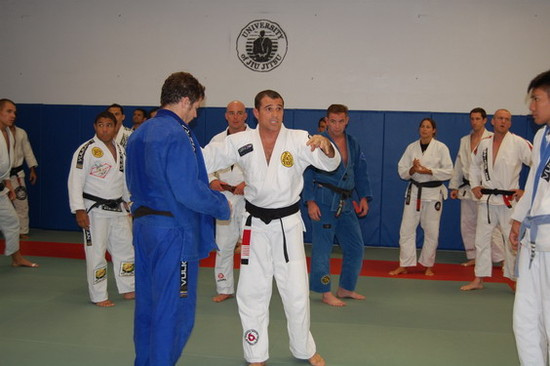[First published in 2012.]
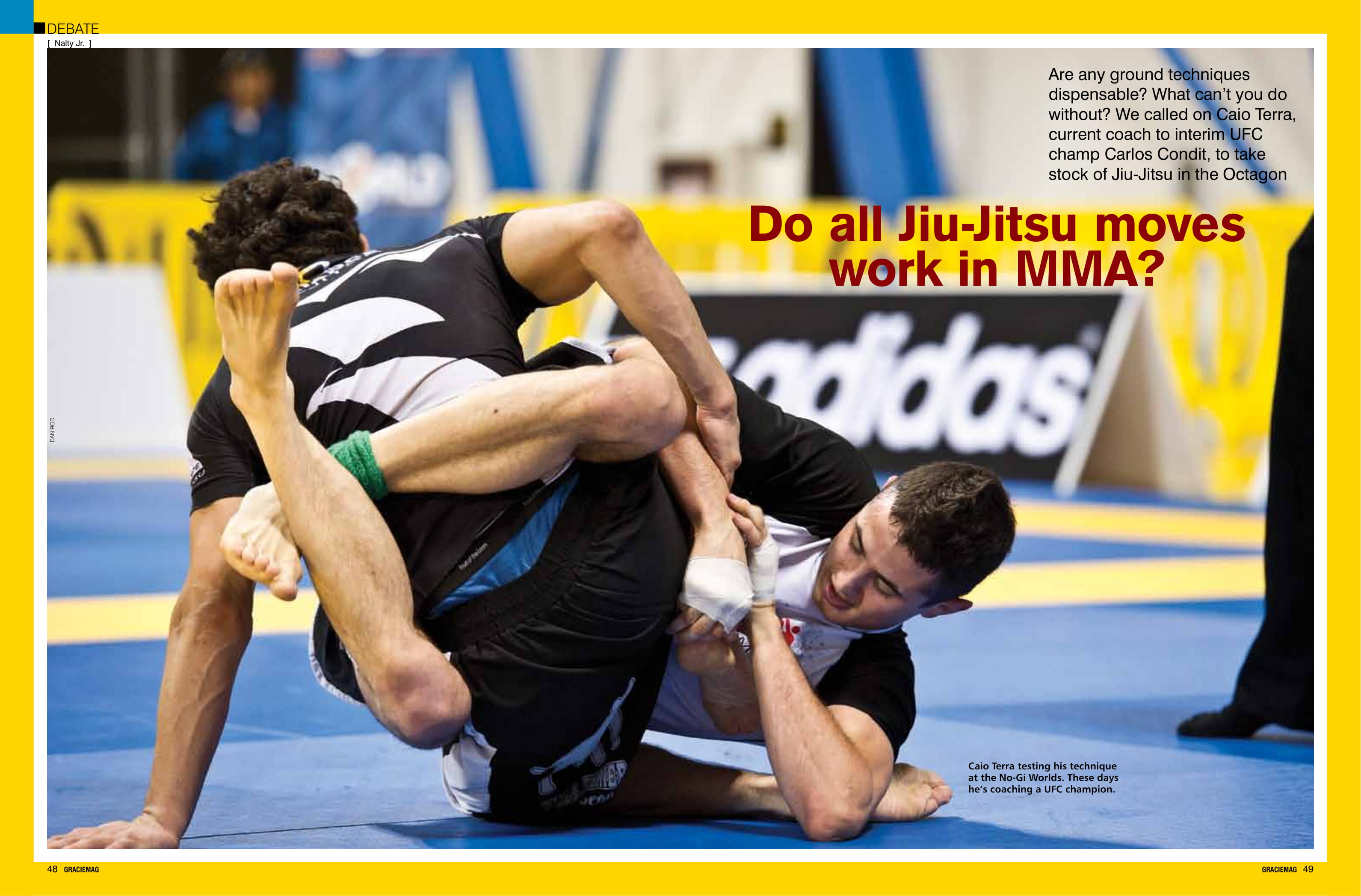
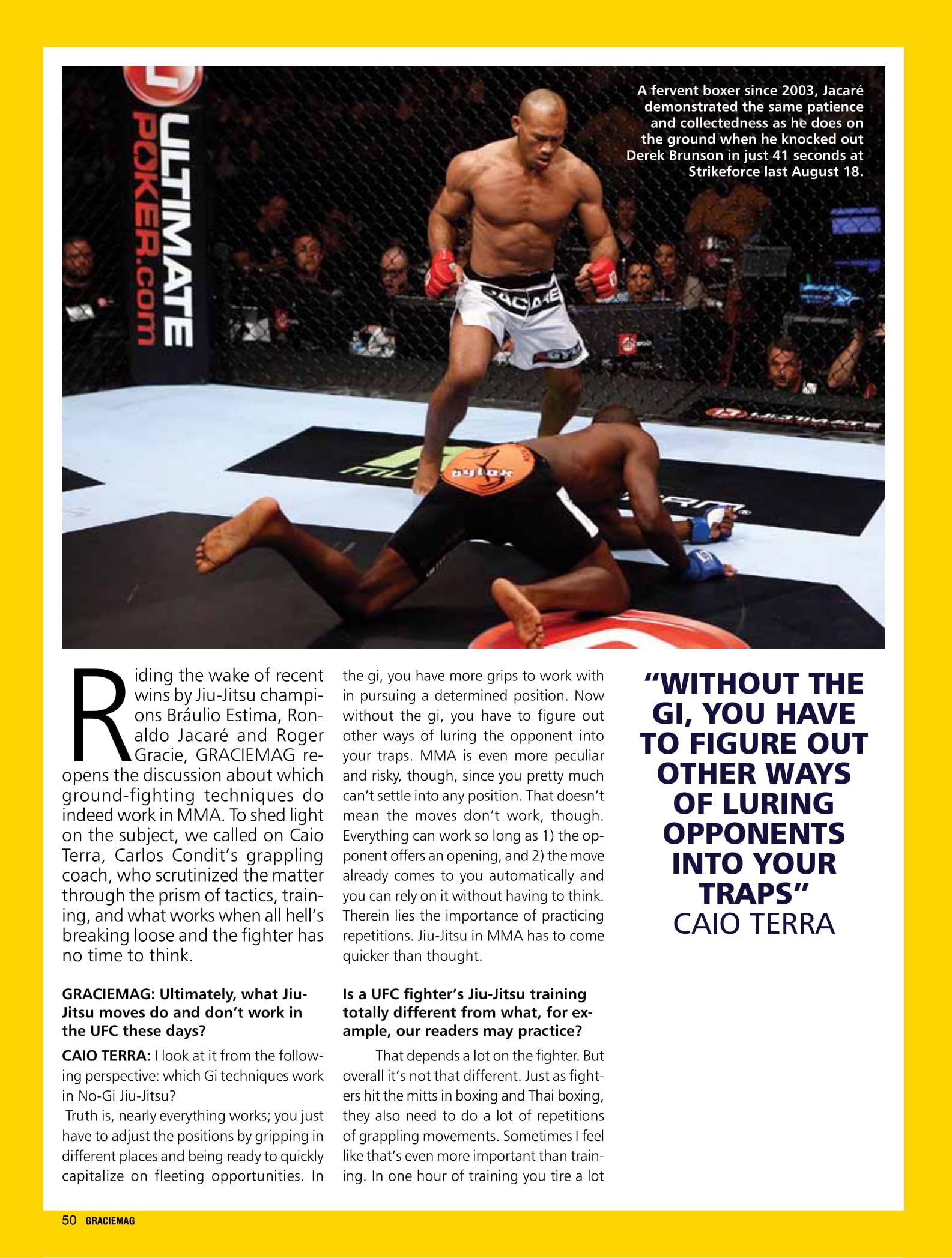
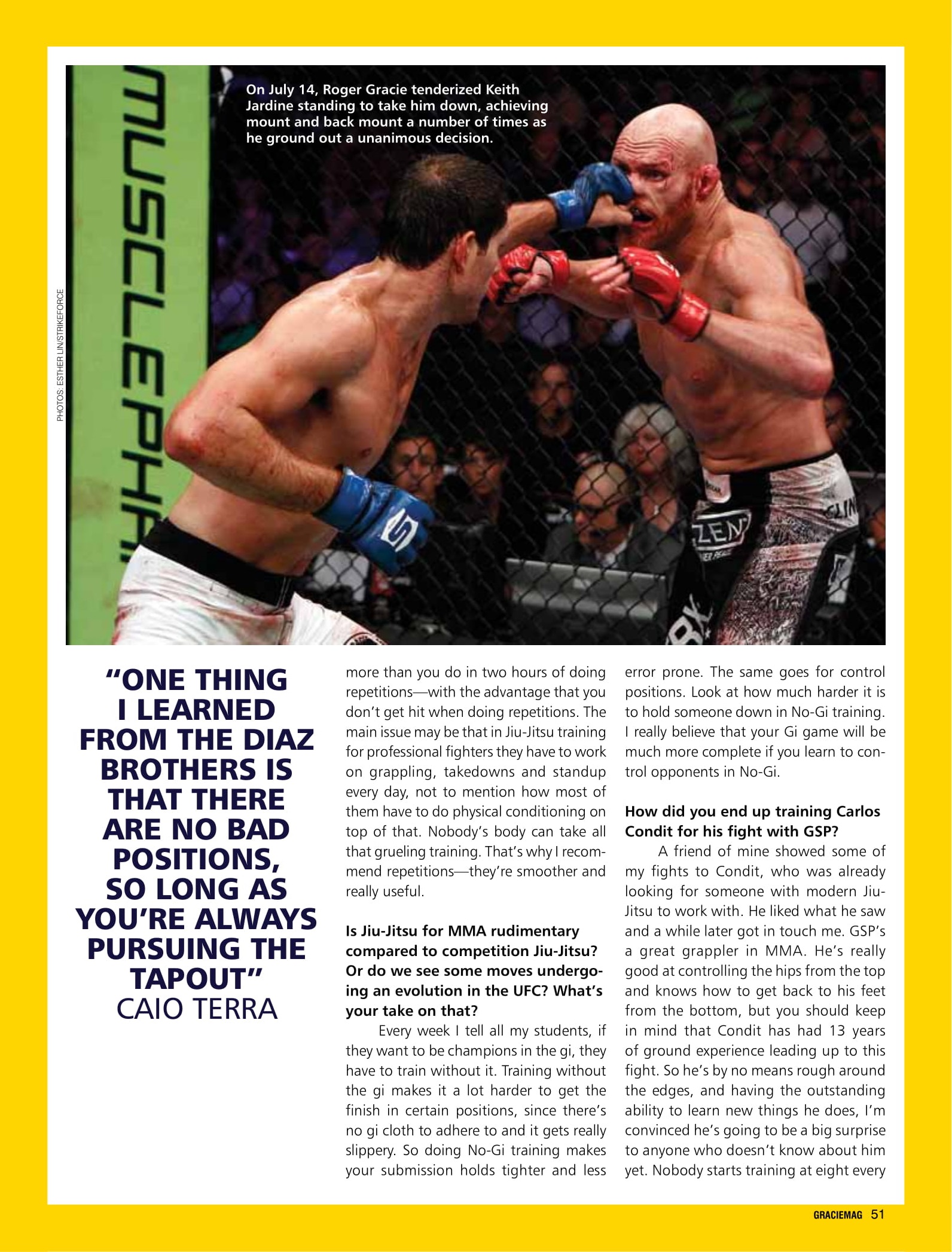
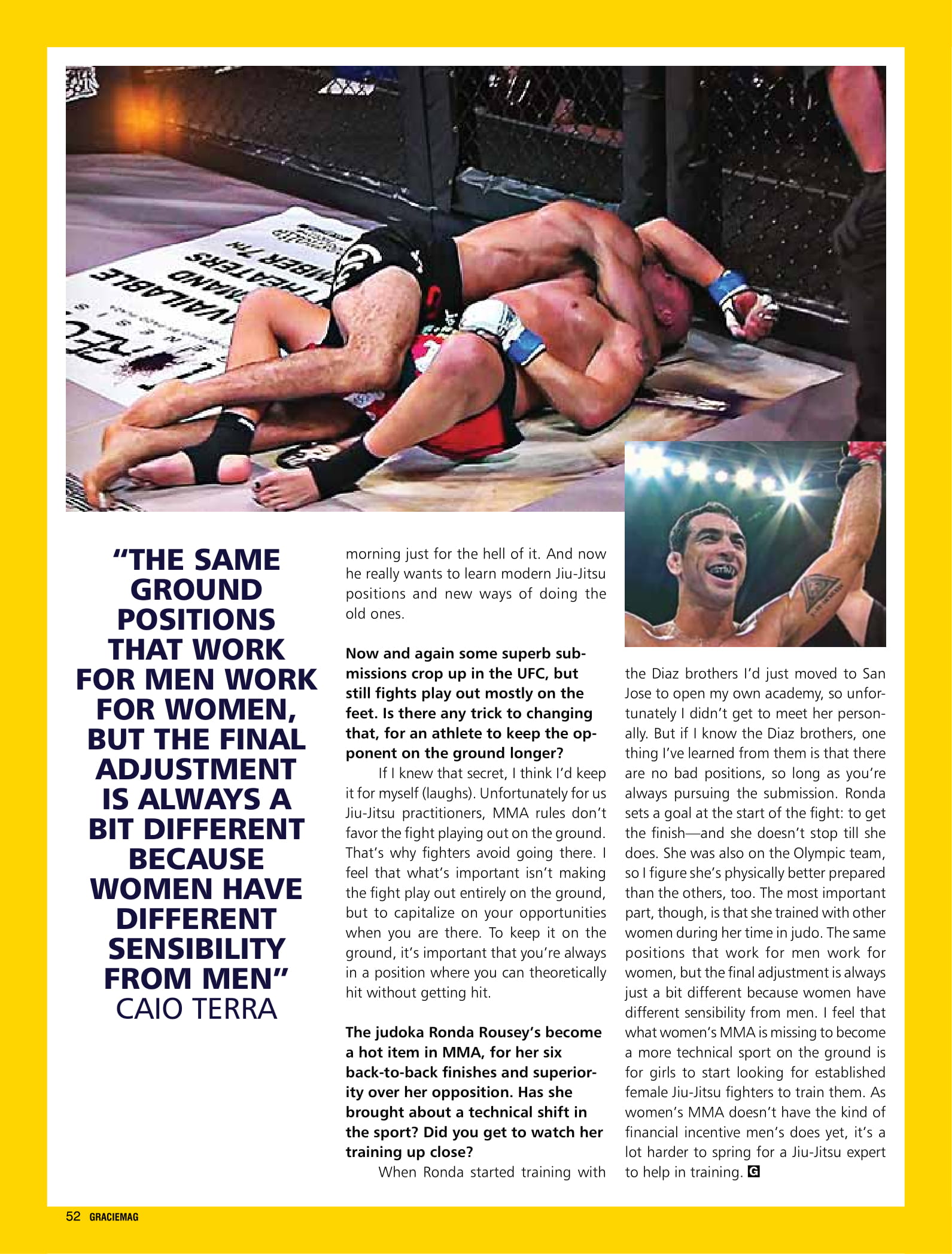
Riding the wake of recent
wins by Jiu-Jitsu champions
Bráulio Estima, Ronaldo
Jacaré and Roger
Gracie, GRACIEMAG reopens
the discussion about which
ground-fighting techniques do
indeed work in MMA. To shed light
on the subject, we called on Caio
Terra, Carlos Condit’s grappling
coach, who scrutinized the matter
through the prism of tactics, training,
and what works when all hell’s
breaking loose and the fighter has
no time to think.
GRACIEMAG: Ultimately, what Jiu-
Jitsu moves do and don’t work in
the UFC these days?
CAIO TERRA: I look at it from the following
perspective: which Gi techniques work
in No-Gi Jiu-Jitsu?
Truth is, nearly everything works; you just
have to adjust the positions by gripping in
different places and being ready to quickly
capitalize on fleeting opportunities. In
the gi, you have more grips to work with
in pursuing a determined position. Now
without the gi, you have to figure out
other ways of luring the opponent into
your traps. MMA is even more peculiar
and risky, though, since you pretty much
can’t settle into any position. That doesn’t
mean the moves don’t work, though.
Everything can work so long as 1) the opponent
offers an opening, and 2) the move
already comes to you automatically and
you can rely on it without having to think.
Therein lies the importance of practicing
repetitions. Jiu-Jitsu in MMA has to come
quicker than thought.
Is a UFC fighter’s Jiu-Jitsu training
totally different from what, for example,
our readers may practice?
That depends a lot on the fighter. But
overall it’s not that different. Just as fighters
hit the mitts in boxing and Thai boxing,
they also need to do a lot of repetitions
of grappling movements. Sometimes I feel
like that’s even more important than training.
In one hour of training you tire a lot
more than you do in two hours of doing
repetitions—with the advantage that you
don’t get hit when doing repetitions. The
main issue may be that in Jiu-Jitsu training
for professional fighters they have to work
on grappling, takedowns and standup
every day, not to mention how most of
them have to do physical conditioning on
top of that. Nobody’s body can take all
that grueling training. That’s why I recommend
repetitions—they’re smoother and
really useful.
Is Jiu-Jitsu for MMA rudimentary
compared to competition Jiu-Jitsu?
Or do we see some moves undergoing
an evolution in the UFC? What’s
your take on that?
Every week I tell all my students, if
they want to be champions in the gi, they
have to train without it. Training without
the gi makes it a lot harder to get the
finish in certain positions, since there’s
no gi cloth to adhere to and it gets really
slippery. So doing No-Gi training makes
your submission holds tighter and less
error prone. The same goes for control
positions. Look at how much harder it is
to hold someone down in No-Gi training.
I really believe that your Gi game will be
much more complete if you learn to control
opponents in No-Gi.
How did you end up training Carlos
Condit for his fight with GSP?
A friend of mine showed some of
my fights to Condit, who was already
looking for someone with modern Jiu-
Jitsu to work with. He liked what he saw
and a while later got in touch me. GSP’s
a great grappler in MMA. He’s really
good at controlling the hips from the top
and knows how to get back to his feet
from the bottom, but you should keep
in mind that Condit has had 13 years
of ground experience leading up to this
fight. So he’s by no means rough around
the edges, and having the outstanding
ability to learn new things he does, I’m
convinced he’s going to be a big surprise
to anyone who doesn’t know about him
yet. Nobody starts training at eight every
morning just for the hell of it. And now
he really wants to learn modern Jiu-Jitsu
positions and new ways of doing the
old ones.
Now and again some superb submissions
crop up in the UFC, but
still fights play out mostly on the
feet. Is there any trick to changing
that, for an athlete to keep the opponent
on the ground longer?
If I knew that secret, I think I’d keep
it for myself (laughs). Unfortunately for us
Jiu-Jitsu practitioners, MMA rules don’t
favor the fight playing out on the ground.
That’s why fighters avoid going there. I
feel that what’s important isn’t making
the fight play out entirely on the ground,
but to capitalize on your opportunities
when you are there. To keep it on the
ground, it’s important that you’re always
in a position where you can theoretically
hit without getting hit.
The judoka Ronda Rousey’s become
a hot item in MMA, for her six
back-to-back finishes and superiority
over her opposition. Has she
brought about a technical shift in
the sport? Did you get to watch her
training up close?
When Ronda started training with
the Diaz brothers I’d just moved to San
Jose to open my own academy, so unfortunately
I didn’t get to meet her personally.
But if I know the Diaz brothers, one
thing I’ve learned from them is that there
are no bad positions, so long as you’re
always pursuing the submission. Ronda
sets a goal at the start of the fight: to get
the finish—and she doesn’t stop till she
does. She was also on the Olympic team,
so I figure she’s physically better prepared
than the others, too. The most important
part, though, is that she trained with other
women during her time in judo. The same
positions that work for men work for
women, but the final adjustment is always
just a bit different because women have
different sensibility from men. I feel that
what women’s MMA is missing to become
a more technical sport on the ground is
for girls to start looking for established
female Jiu-Jitsu fighters to train them. As
women’s MMA doesn’t have the kind of
financial incentive men’s does yet, it’s a
lot harder to spring for a Jiu-Jitsu expert
to help in training.


